16 Minimalist Nursery Ideas for Simple Elegance
Creating a nursery that exudes simple elegance has become a popular choice for parents seeking a serene and clutter-free environment for their little one. Minimalist nursery ideas are loved for their clean lines, soothing color palettes, and functional design, making spaces feel peaceful and spacious.
In this article, you’ll discover a variety of inspiring ideas that blend practicality with beauty. From neutral tones to sleek furniture, these suggestions will help you craft a calm, stylish haven for your baby that’s both easy to maintain and visually captivating.
1. Neutral Color Palette Walls for Calm & Clarity
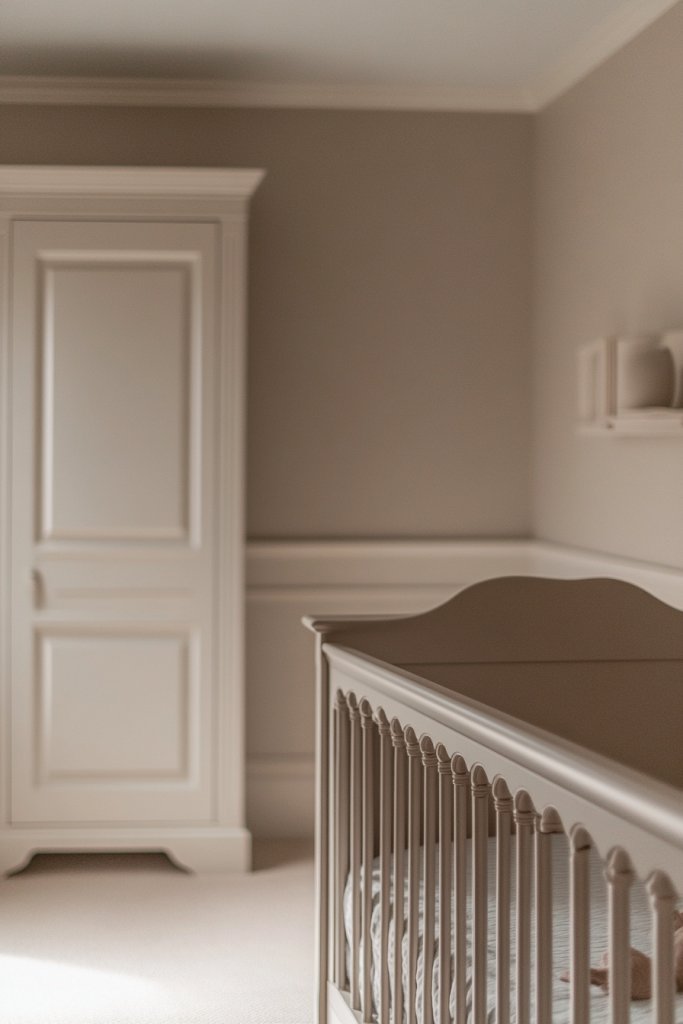
Ever walk into a nursery and feel overwhelmed by bright colors or busy patterns? A calming space is what every parent dreams of, especially when relaxation and sleep are on the line. The right wall colors set the tone for a peaceful environment and help both baby and parents unwind. But choosing the perfect palette can feel daunting with so many options flooding Pinterest.
Imagine soft, gentle walls painted in shades like warm beige, subtle taupe, or cool off-white. The surface absorbs ambient light, creating a serene glow that makes the room feel spacious yet cozy. The muted tones act as a perfect backdrop for simple, functional furniture—think unadorned wooden cribs and sleek storage units. This minimal use of color lets textures and natural materials stand out without visual clutter.
You can adapt this palette seasonally by swapping out textiles or adding colorful accessories like cushions or throws. For a more gender-neutral look, stick to earthy tones; for a touch of softness, pastel shades work well. If space is limited, opt for lighter hues to make the room feel bigger. Conversely, darker muted tones add intimacy in larger rooms. Personalize it further with textured paints or matte finishes for depth.
Start with a color sample kit to test how different shades look in your space at various times of the day. Choose low-VOC, non-toxic paints suitable for nurseries. Prepare your walls by cleaning and patching imperfections before applying primer if needed. Use painter’s tape to create clean edges around windows, trim, or ceiling lines. Two coats usually suffice, but always follow manufacturer drying instructions for best results. Finish with a matte or eggshell finish to reduce glare.
Incorporate subtle visual textures by adding wall decals or textured wallpaper accents that complement your color palette. Use fabric-covered pinboards or cork boards in neutral tones for personal mementos instead of cluttering walls with art. Consider painting a small accent wall with a slightly darker shade for visual interest. Keep accessories minimal, focusing on high-quality, durable finishes that age gracefully.
A neutral palette creates a timeless nursery that grows with your child, reducing the need for frequent redecorations. It’s also easier to update with small accessories later on. Plus, calming colors promote better sleep and relaxation—key for new parents. Trust that simple, elegant walls can serve as the perfect backdrop for a peaceful nursery that’s both stylish and functional.
2. Floating Shelves for Discreet Storage and Display
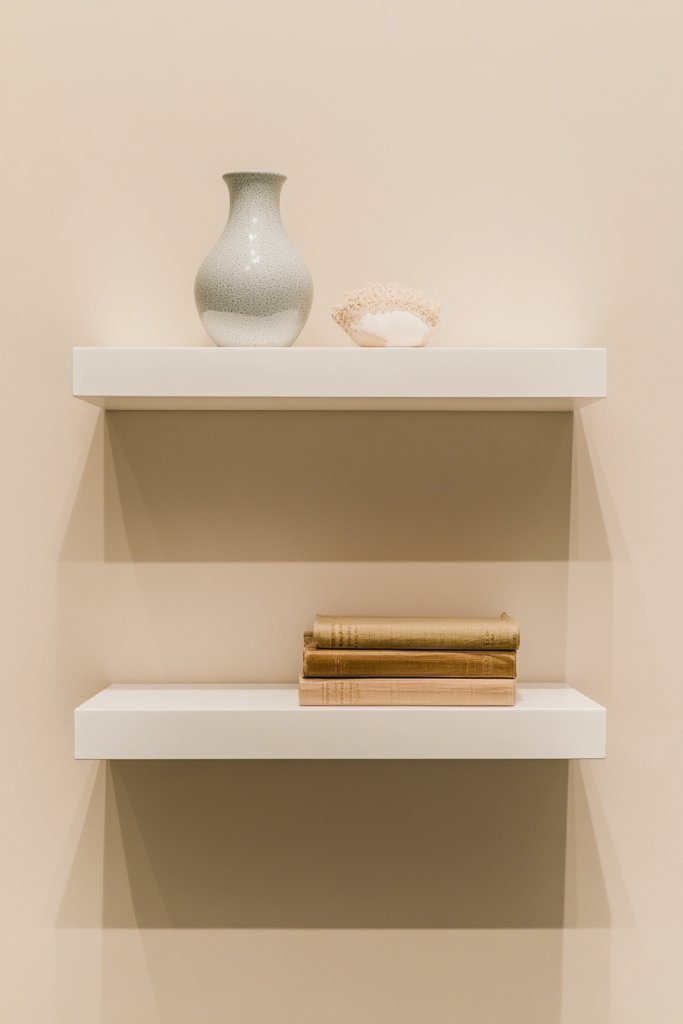
Clutter in a nursery can turn a serene space into chaos real quick. Parents crave smart solutions that hide away essentials but still keep them within reach. Floating shelves offer a sleek, modern way to organize toys, books, or essentials without taking up valuable floor space. Plus, they add a subtle decorative touch, so your nursery doesn’t look like a storage unit.
Picture slim, wall-mounted shelves in matte black, natural wood, or painted finishes blending into your wall color. They seem to hover effortlessly, providing a platform for neatly arranged baskets, plush toys, or carefully stacked books. The open design keeps everything visible but organized, avoiding that cluttered feeling. When lit with soft ambient light, these shelves cast gentle shadows, adding depth and warmth to the room.
Use different sizes and shapes of shelves to create visual interest or designate areas—for example, a small shelf for bedtime stories and a larger one for toys. You can also stagger shelves at varying heights to accommodate different items. In smaller rooms, install shelves above the changing station or crib for easy access. For seasonal decor, swap out items on the shelves to refresh the look without a full redecorating.
Choose shelves made from sturdy material like solid wood or engineered wood with a clear mounting system. Use a level to mark where the brackets will go, ensuring a clean, straight look. Secure brackets into wall studs for maximum weight support—don’t rely solely on drywall anchors. Finish by arranging baskets or containers to keep small items tidy. Regularly check the mounting for stability, especially if children start pulling or climbing.
Add small decorative elements like sculptural objects or fabric-lined baskets to soften the look. Personalize with labels or tags to encourage independence, like ‘Books’ or ‘Toys.’ Paint the shelves in a contrasting or complementary color to your wall for a pop of visual interest. Incorporate lighting underneath or above for a cozy glow during night-time visits.
Floating shelves turn clutter into curated displays, making your nursery look effortlessly put-together. They help teach your little one organization skills early on while keeping essentials accessible. With minimal hardware and a simple setup, you can easily change the layout as your child grows. This stylish storage solution proves that functional doesn’t have to mean cluttered.
3. Simple Wooden Crib with Clean Lines
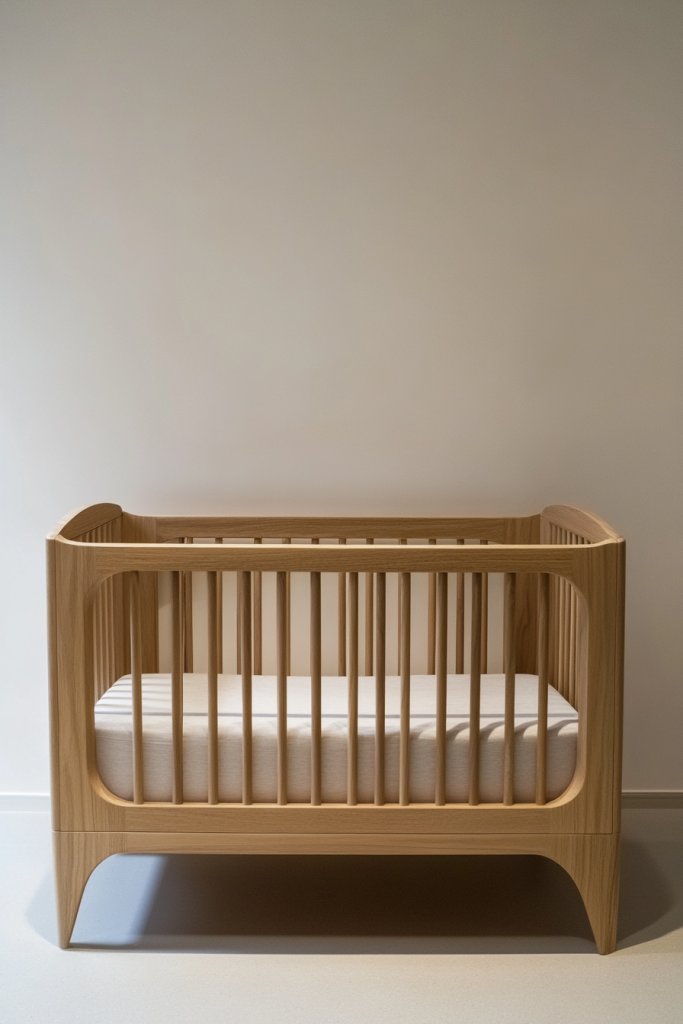
A crib is the centerpiece of any nursery, but many designs are overly ornate or bulky. Parents want something sleek, safe, and timeless—without sacrificing style. The right minimalist crib with clean lines instantly elevates the room’s aesthetic and creates a calming environment. It’s also easier to keep clean and maintain, making busy parent life a bit simpler.
Imagine a solid wood crib with smooth, unadorned surfaces painted in matte white, natural oak, or muted gray. Its simple silhouette features straight edges and subtle curves, exuding a modern yet cozy vibe. The slatted sides allow visibility and airflow, while the sturdy frame provides peace of mind. Surround it with soft textiles and neutral-toned bedding for a harmonious, uncluttered look.
Choose a convertible design that transitions from crib to toddler bed, extending its lifespan and saving money. For small spaces, opt for a compact or low-profile model that’s easier for parents to access. For a more personalized touch, select a crib with subtle architectural details, like tapered legs or integrated storage drawers. Seasonal bedding swaps and textured blankets can add visual interest without clutter.
Select a crib that meets all safety standards, paying attention to slat spacing and non-toxic finishes. Assemble on a flat, stable surface, following manufacturer instructions carefully. Use a level to ensure the mattress platform is perfectly horizontal. Secure all bolts tightly and regularly check for stability. Dress the crib with fitted sheets and simple, soft bedding—avoid excess pillows or bumpers for safety.
Personalize with a custom-made name plaque or a soft, textured blanket draped over a corner. Use washable, neutral bedding that complements the overall color scheme. You can also add a small, sculptural mobile or a soft fabric canopy for a touch of whimsy—just keep it simple and safe. Consider pairing the crib with a matching nightstand or storage unit for cohesive styling.
A minimalist wooden crib offers a timeless foundation that grows with your child. Its clean design means it won’t feel outdated quickly, making your nursery feel calm and organized. Plus, the simplicity allows you to focus on creating a warm, nurturing environment rather than distracting decor. It’s the perfect blend of safety, style, and practicality—peace of mind included.
4. Understated Textile Swaddles and Bedding

Tangled, mismatched blankets are a nightmare for new parents. They want bedding that’s simple, soothing, and easy to coordinate. Understated textiles make the nursery look polished and calm, without adding visual noise. Plus, choosing the right fabrics can improve comfort and sleep quality for your little one.
Visualize soft, solid-colored swaddles in muted tones like blush, cream, or light gray. They drape gently over a crib or are folded neatly on a shelf, adding subtle texture. The fabrics have a matte finish, with gentle textures like cotton, muslin, or linen, which catch the light softly. Layering these textiles creates a cozy, inviting space that’s tactile and calming.
Mix and match textiles with different textures—think smooth cotton, ribbed knit, or subtly textured linen—for depth. Use monochromatic color schemes for a cohesive look, or introduce gentle patterns like tiny dots or stripes in the same muted palette. Seasonal options include lightweight fabrics for summer and cozy, brushed textiles for winter. For a more personalized touch, add embroidered initials or subtle piping details.
Choose high-quality, hypoallergenic fabrics that are gentle on sensitive skin. Wash all textiles before use to remove any manufacturing residues. Use fitted sheets on the crib mattress to keep bedding tidy. When layering, fold or roll textiles neatly for easy access and storage. Opt for machine-washable options for hassle-free cleaning, and avoid overly textured or bulky fabrics that can trap heat or dust.
Coordinate textiles with other nursery elements for a seamless look—like matching curtains or textured rugs. Add a soft, neutral throw blanket for your own comfort during late-night feeds. Use subtle trims or piping in a slightly different shade to add a refined touch. Personalize with small embroidered patches or tags that can be easily removed or changed over time.
Simple, understated textiles promote a peaceful sleep environment and a clutter-free aesthetic. They’re easy to update as your child grows or as your style evolves. A nursery that feels soft and uniform helps foster a sense of calm and security for your baby. Trust that minimal, high-quality fabrics can make a big difference in creating a serene space.
5. Modular Storage Biles with Hidden Compartments
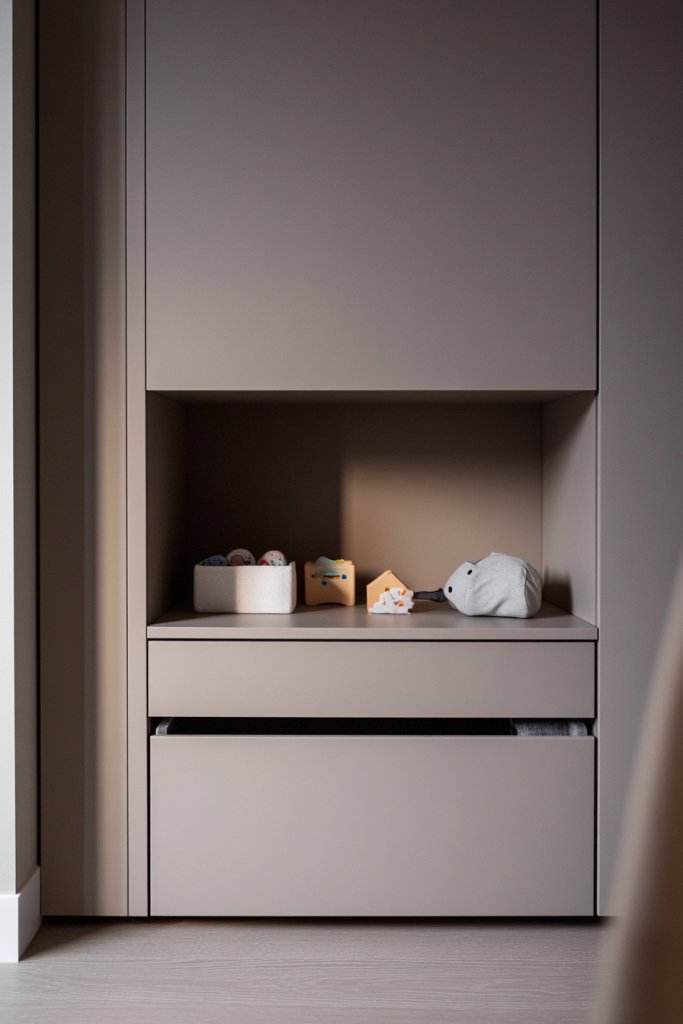
Ever feel like toy bins and cluttered drawers turn your nursery into a chaotic mess? Parents are craving clever storage options that hide clutter and keep the room looking sleek. Modular storage units with hidden compartments offer a smart solution, combining functionality with a clean aesthetic. They allow quick tidying and give your nursery a polished vibe.
Picture a set of matte finish modular cubes in neutral tones stacked neatly against the wall. Some compartments are open, perfect for baskets or plush toys, while others hide away essentials behind sleek, push-to-open doors. The seamless design minimizes visual clutter, creating a calm, organized space. When closed, these units blend into the background, making the room feel uncluttered and spacious.
Choose units with configurable modules to adapt to your changing needs—more shelves, drawers, or concealed compartments. Use soft fabric-lined baskets inside open sections for smaller items. For a more streamlined look, select furniture with integrated hidden storage in the base or sides. Seasonal or thematic accessories—like fabric covers or labels—can add personality without disrupting the clean lines.
Measure your available space carefully before purchasing. Opt for durable, non-toxic materials like MDF or engineered wood with smooth finishes. Assemble according to the instructions, ensuring all compartments open smoothly and stay secure. Use organizers or fabric bins inside open sections for small items, and regularly declutter for optimal functionality. Secure units to the wall to prevent tipping, especially in active households.
Label drawers with subtle, minimalist tags or fabric patches to identify contents. Incorporate a few decorative elements like textured knobs or handles that match your nursery theme. Use removable liners inside compartments to protect surfaces and ease cleaning. Consider adding a pop of color with painted edges or accents for visual interest.
Modular storage with hidden compartments keeps your nursery tidy without sacrificing style. It encourages organization habits early, making cleanup faster and less stressful. The sleek design makes it easy to adapt as your child grows or as your storage needs change. With a little planning, you can have both a beautiful and clutter-free nursery.
6. Soft, Low-Profile Rug for Comfort and Style

A cold, hard floor can make a nursery less inviting and more stressful to keep clean. Parents want a soft, comfortable area where babies can play and crawl freely without sacrificing style. A low-profile rug adds warmth, defines the space, and enhances overall comfort. But finding one that’s simple and elegant without overwhelming the room isn’t always straightforward.
Imagine a plush, neutral-toned rug in shades of warm beige, soft gray, or muted taupe laid out under the crib. Its low pile offers a gentle surface that’s safe for tiny hands and knees. The subtle texture creates visual depth without cluttering the space. The rug anchors the room, tying together furniture and textiles with a cohesive, minimalist vibe.
Choose a rug that complements your color palette—think solid or subtle geometric patterns in muted tones. For a more playful twist, select rugs with textured patterns or woven details, but avoid loud colors or busy designs. In smaller rooms, opt for a narrow runner to maximize space. Seasonal layering with a cozy blanket or throw can refresh the look without replacing the entire rug.
Measure your space carefully before selecting a rug size—aim for a size that leaves enough room for movement but doesn’t overpower the room. Look for durable, easy-to-clean materials like wool blends or synthetic fibers with stain resistance. Vacuum regularly and spot-clean as needed to maintain freshness. Use non-slip pads underneath to prevent slipping or bunching, especially in high-traffic areas.
Add a textured throw or a small, decorative cushion in complementary shades for extra comfort. Layer with a smaller, patterned mat for visual interest and tactile variety. Incorporate a scent-free, natural fiber rug for allergy-sensitive environments. Keep it simple: avoid excessive trims or fringes that can trap dust or pose a safety hazard.
A soft, low-profile rug creates a welcoming space that encourages exploration and play. Its simple design makes it easy to update with new textiles or accents over time. A comfortable floor boosts both baby’s comfort and your peace of mind. It’s a small investment that makes a big difference in creating a cozy nursery environment.
7. Minimalist Wall Hooks for Hanging Essentials
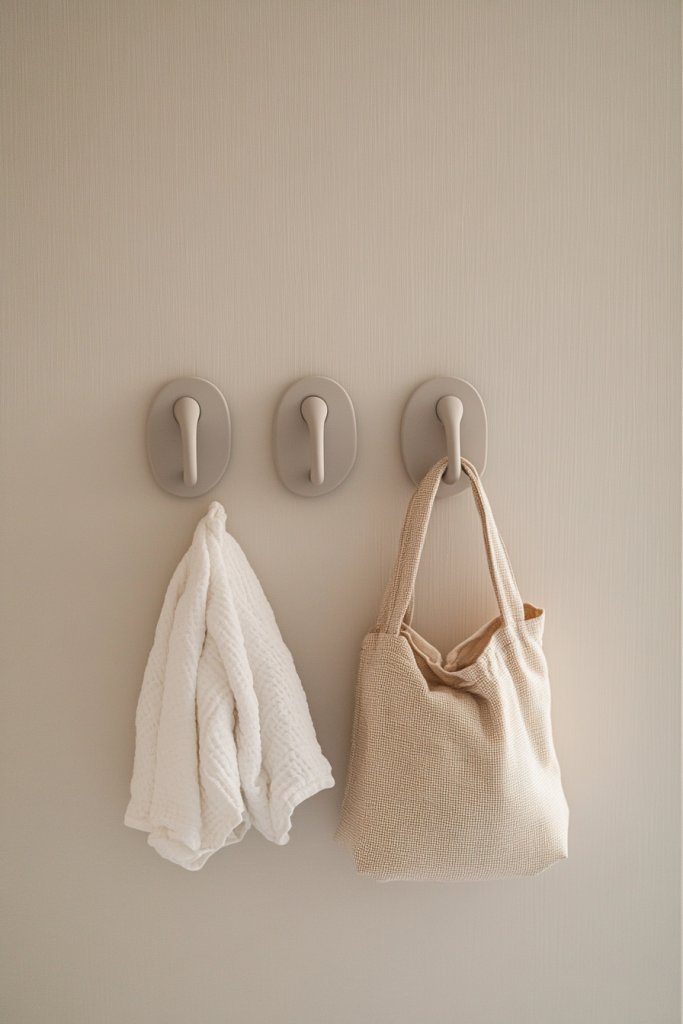
Cluttered hooks and overcrowded changing stations make a nursery look messy and unorganized. Parents crave a simple, efficient way to keep everyday essentials within reach without sacrificing style. Minimalist wall hooks provide a sleek solution, turning functionality into a design feature. It’s amazing how a few well-chosen hooks can transform the space.
Visualize a series of slim, matte black or brushed metal hooks mounted in a neat row above the changing table or beside the crib. They hold lightweight items like hats, diaper bags, or small accessories, hanging effortlessly against a muted wall. The minimalist design keeps the space feeling open and uncluttered while providing practical storage. The hooks blend seamlessly into the overall aesthetic, almost invisible until needed.
Arrange hooks in a linear or staggered pattern depending on your space and style. Use different finishes—matte black, brass, or painted wood—to match your nursery’s theme. For added personality, incorporate hooks with subtle sculptural details or textured finishes. You can also group multiple hooks in clusters for a more dynamic look, especially in larger rooms.
Choose hooks that are sturdy enough to support lightweight items but easy to install without damaging walls. Mark positions with a level and pencil before drilling. Secure hooks into wall studs or use appropriate anchors for drywall. Keep mounting hardware minimal, and consider adding a protective clear coat for longevity. Regularly check the hooks for stability as your child grows.
Add small decorative elements like leather straps or fabric wraps to customize the hooks and match your decor. Use labels or tags to organize items hanging from each hook, fostering independence as your child grows. Incorporate hooks with built-in storage compartments or small baskets for extra functionality. Keep the look clean by limiting the number of hooks used.
Minimalist wall hooks are a practical and stylish addition that keeps essentials accessible and organized. They make cleaning easier and help teach organization skills early. Their simple design complements a variety of nursery styles, from modern to Scandinavian. With a few thoughtful choices, you create a functional space that feels calm and clutter-free.
8. Compact Changing Station with Hidden Storage
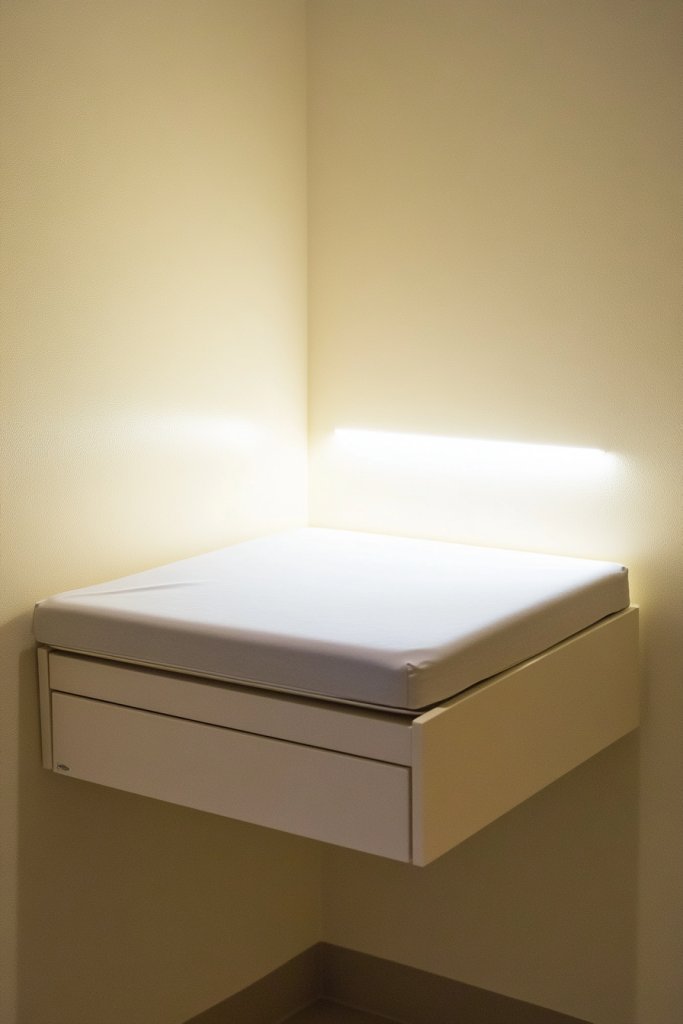
A cluttered, sprawling changing station can turn diaper duty into a chore. Parents want a compact, tidy setup that keeps everything they need within arm’s reach but out of sight. Hidden storage options make this possible, transforming a messy task into a quick, stress-free routine. Who doesn’t want a cleaner, more organized space?
Imagine a sleek changing table with a smooth, unadorned surface in soft wood or painted in a muted tone. Beneath the top, concealed drawers or cabinets hide wipes, creams, and spare clothing. The design minimizes visual clutter, making the station look neat and modern. When closed, it looks like a simple piece of furniture, seamlessly blending into the nursery ambiance.
Choose a wall-mounted changing station for tiny spaces, freeing up floor area. For larger rooms, opt for a combination dresser and changing surface in one, with hidden compartments inside. Incorporate soft-close drawers or push-to-open mechanisms for a seamless look. Add removable fabric bins or trays inside for organizing smaller essentials. Adjust height and size based on your space and ergonomic needs.
Select a sturdy, non-toxic material suited for frequent use, like painted MDF or hardwood. Install on a secure, flat surface, ensuring stability. Use a level to align the changing surface perfectly. Incorporate soft, washable covers for comfort, and keep frequently used items in easy-to-reach hidden compartments. Regularly check the hardware for safety and durability.
Personalize with a custom drawer label set or decorative knobs. Use soft, neutral-colored changing pads to match the room’s aesthetic. Add a few small, decorative touches like textured handles or contrasting drawer fronts for visual interest. Keep supplies organized with small containers or dividers inside the hidden compartments.
A compact changing station with hidden storage makes diaper changes faster and less messy. It encourages a tidy, organized routine that’s easy to maintain. Its sleek design complements a minimalist nursery, proving that practicality and style can go hand in hand. You’ll feel more confident tackling diaper duty with everything neatly tucked away.
9. Clean-Lined Floor Lamp for Gentle Lighting
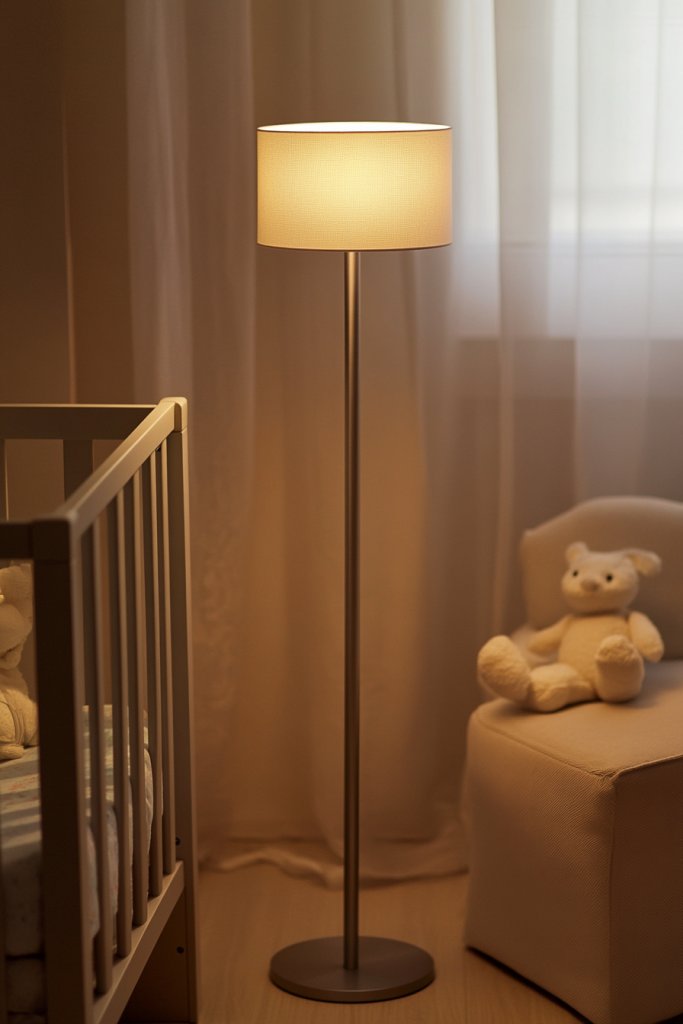
Bright overhead lighting can be harsh and disruptive during late-night feedings or diaper changes. Parents want a soft, ambient light source that creates a calming atmosphere. A clean-lined floor lamp with a minimalist design offers gentle illumination without cluttering the nursery’s sleek aesthetic. It’s a small detail that makes a big difference.
Visualize a slender, matte black or soft white floor lamp standing unobtrusively in a corner. Its slim profile and simple shade cast a warm, diffuse glow over the room. The subtle design blends into the background, offering function without distraction. When turned on, it provides just enough light to see clearly while maintaining a cozy, inviting environment.
Choose a lamp with adjustable brightness or a dimmer switch to tailor lighting levels for different activities. For a modern look, select a sleek metal or matte finish; for softer aesthetics, opt for a fabric shade in neutral tones. Position the lamp near the changing station or beside the rocking chair for versatility. Use a matching or contrasting cord cover to keep the look tidy.
Pick a lamp with a stable base and easy-to-use switch, ideally with energy-efficient bulbs. Place it where it won’t be knocked over by curious little hands. Use a plug-in model with a long cord or a wireless rechargeable option for flexibility. Adjust the height and angle to direct light precisely where needed. Keep cords hidden or secured to prevent tripping hazards.
Add a soft fabric or paper shade in a neutral tone to diffuse light gently. Incorporate a small decorative element like a textured base or a sculptural stand for visual interest. Pair with a cozy blanket or textured cushion nearby to enhance the relaxed ambiance. You could also consider a smart bulb for adjustable color temperature, creating a calming glow.
A minimalist floor lamp elevates the nursery’s atmosphere, proving that lighting is more than just functional—it’s mood setting. It helps create a peaceful environment that fosters better sleep and easier night-time routines. With simple, clean lines, it complements your overall decor and adds a touch of subtle elegance to your space.
10. Uncluttered Window Treatments in Light Fabrics
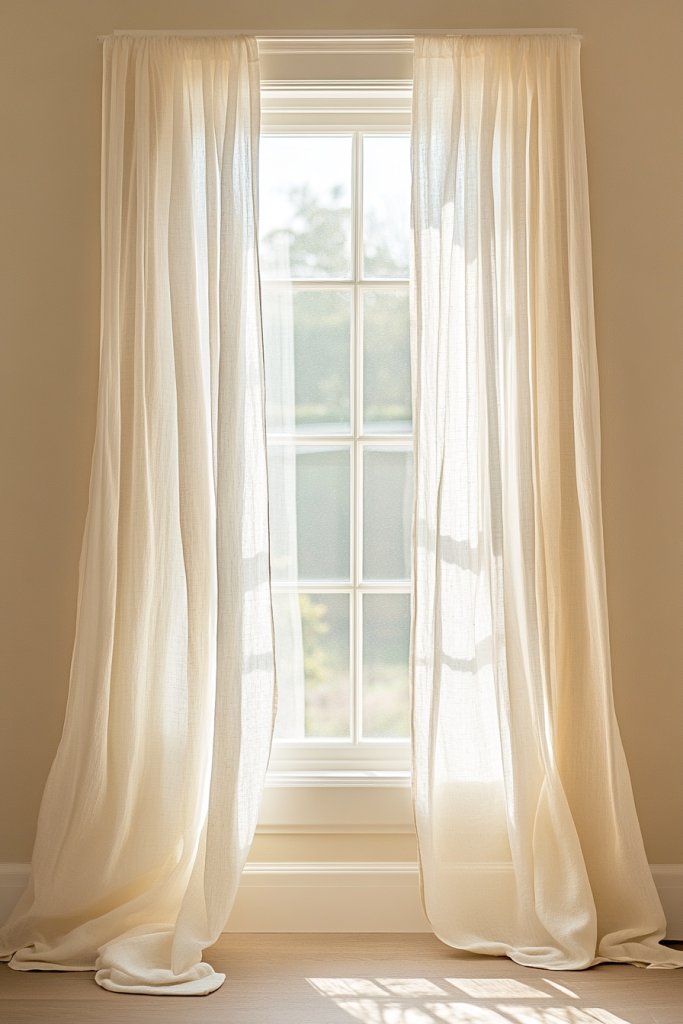
Heavy or overly patterned curtains can block natural light and make a nursery feel cramped. Parents want window treatments that let in sunlight, maintain privacy, and look effortlessly elegant. Light, sheer fabrics in simple styles achieve all this without cluttering the room’s minimalist vibe. It’s a small change that brightens the entire space.
Picture sheer, white or soft-colored roller blinds or curtains flowing gently in the breeze. The translucent fabrics filter sunlight softly, creating a bright, airy atmosphere. The clean, simple lines of the window coverings emphasize the room’s uncluttered aesthetic. When pulled back, the windows become a focal point with uninterrupted views and natural light flooding in.
Opt for roller blinds, Roman shades, or simple panel curtains in light fabrics like linen or voile. For privacy at night or in bright neighborhoods, layer with blackout shades behind sheer curtains. Use minimal hardware, like sleek rods or track systems, to keep the look seamless. For a seasonal update, swap out fabrics for textured or patterned options in complementary tones.
Measure your windows carefully before purchasing. Choose high-quality, light-filtering fabrics that are easy to clean—machine washable is ideal. Install hardware with minimal hardware brackets, ensuring they are level and securely anchored. Use tension rods or discreet hooks for easy removal and cleaning. Regularly dust or wash curtains to keep the space feeling fresh.
Add subtle trims or piping in matching or contrasting colors to elevate the simple fabric. Consider tiebacks in soft textiles for a tidy look when windows are open. Use a light, neutral color palette to keep the room feeling spacious. Personal touches like a small fabric bow or decorative clips can add a dash of personality without clutter.
Uncluttered window treatments enhance the flow of natural light, making your nursery feel larger and more inviting. They’re easy to maintain and adaptable for changing seasons. Simple, light fabrics foster a peaceful environment that encourages rest and relaxation. It’s a small detail that makes a big impact in creating a balanced, serene nursery.
11. Artless, Geometric Wall Decals or Stickers
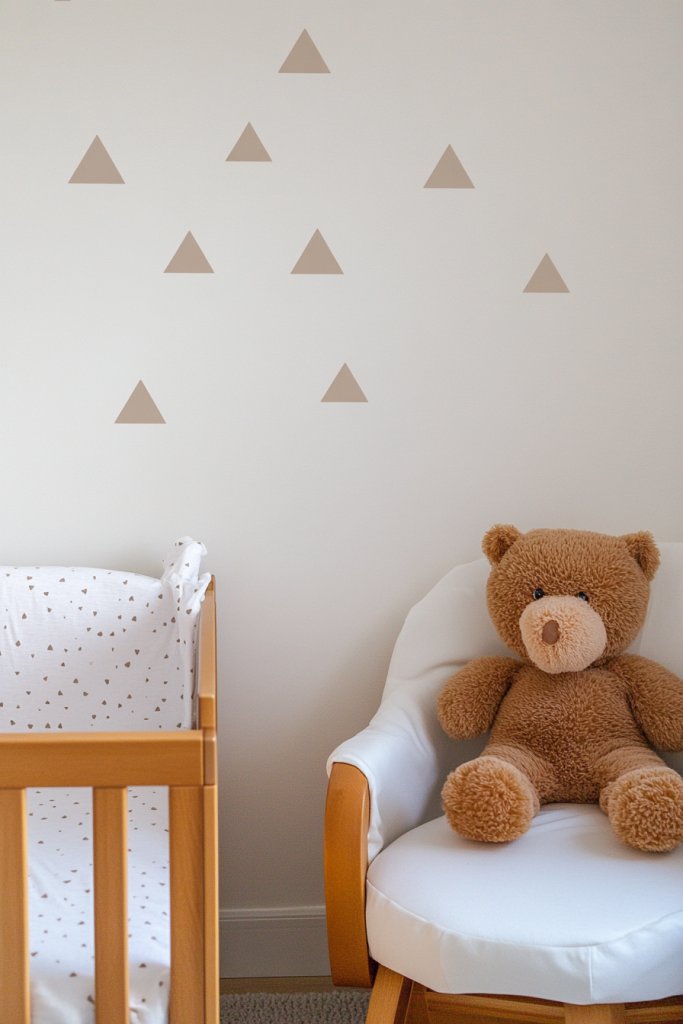
Decorating a nursery with art can quickly become overwhelming and cluttered. Parents want subtle, stylish ways to add visual interest without sacrificing the minimalist aesthetic. Artless geometric wall decals or stickers offer a modern, clean look that can be easily customized and removed. They’re perfect for creating a calm, engaging environment.
Imagine delicate, neutral-toned geometric shapes—triangles, circles, or lines—applied directly onto a blank wall. These decals create a subtle visual rhythm, adding depth and dimension without overwhelming. When lit with soft ambient light, their shadows cast interesting patterns, enriching the room’s visual texture. The decals are simple enough to complement any nursery decor, from Scandinavian to contemporary styles.
Choose decals in monochrome shades or muted pastel tones for a cohesive look. Arrange shapes in a linear pattern for a sleek, modern feel, or cluster them for a playful, abstract composition. Change the configuration over time to refresh the space easily. For a more interactive approach, select decals that can be repositioned without damage.
Clean the wall surface thoroughly before application. Peel and stick decals carefully, starting from one corner and smoothing out air bubbles with a squeegee or credit card. Use a level or masking tape to create straight lines or precise geometric arrangements. Avoid placing decals over textured or uneven surfaces for best results. Remove or reposition decals as your child grows or decorating preferences change.
Pair decals with neutral-colored painted walls for a subtle backdrop. Incorporate matching textiles or accessories for visual harmony. Use decals to highlight specific areas, like around the crib or changing station. Keep the overall design simple and uncluttered, letting the decals add just enough visual interest.
Geometric decals are a clever way to personalize your nursery without overdecorating. They’re easy to update and remove, making them ideal for changing tastes or growing children. Their minimalist appeal helps foster a calm environment that supports restful sleep and exploration. With a few shapes and a steady hand, you can create a stylish, artless nursery that feels intentional and serene.
12. Functional, Unadorned Changing Pad on a Sleek Table

A cluttered, overly decorated changing station can distract from the peaceful nursery vibe. Parents want a simple, functional surface that is easy to clean and looks good in a minimalist space. An unadorned changing pad on a sleek table combines practicality with style, keeping the focus on simplicity. It’s a straightforward upgrade for a tidy, calming environment.
Visualize a smooth, unembellished changing table in natural wood or painted in a muted tone. The plain, firm-changing pad sits securely on top, free of unnecessary accessories. The surface is clutter-free, with only essential items within reach—like a small stack of wipes or a clean diaper in a simple holder. The overall look is clean, organized, and modern, emphasizing function over decoration.
Opt for a floating or wall-mounted changing table to save space. Use a neutral-colored, easy-to-clean changing pad that complements your nursery’s palette. For added safety, install guard rails or side panels that are minimalist in design. Keep accessories hidden or in sleek baskets below for a clutter-free look. Adjust height for ergonomic comfort, depending on your needs.
Select a sturdy, waterproof, and washable changing pad—look for options with non-slip backing. Mount or position the table on a flat, secure surface, ensuring stability. Keep the area around the changing station free of excess clutter, only leaving out essentials. Regularly clean and inspect the pad and table for safety and hygiene. Use a gentle cleaner that’s safe for baby’s sensitive skin.
Add a soft, neutral cover or wrap for comfort, ensuring it’s removable for washing. Incorporate a discreet, minimalist storage solution underneath or nearby for supplies. Use labels or subtle tags to organize items, fostering independence. Keep the overall look consistent with your nursery’s minimalist theme, avoiding ornate or busy patterns.
A simple, functional changing station keeps your nursery looking sleek and organized. It reduces stress during diaper changes and makes cleaning effortless. Its minimalist design can easily adapt as your baby grows or your style evolves. Focus on quality and safety, and you’ll create a practical, beautiful space that feels calm and inviting.
13. Built-In Shelving for Minimalist Storage Solutions

Cluttering up a nursery with freestanding shelves or storage units can break that clean, minimalist vibe. Parents want integrated storage solutions that blend into the architecture, keeping things tidy and visually calm. Built-in shelving offers a seamless look, making the most of wall space while maintaining a sleek aesthetic. It’s a smart way to organize without sacrificing style.
Picture a wall with recessed shelves flush with the wall surface, painted in the same neutral tone. The shelves hold neatly folded blankets, baskets with toys, or essential supplies—everything within arm’s reach. The smooth, uninterrupted surface creates a sense of order and calm. When lit with soft, indirect lighting, the shelves cast gentle shadows, adding depth and elegance.
Design the built-ins with multiple levels and compartments to suit your storage needs. Use open shelves for frequently used items and concealed cabinets for less accessible storage. Incorporate adjustable shelves for flexibility as your child grows. Keep the finish simple—matte or semi-gloss—to enhance the minimalist look. Consider integrating a fold-down changing station within the shelving unit for space-saving functionality.
Work with a contractor or carpenter to design custom shelving that fits your space and style. Use durable, non-toxic materials like painted MDF or natural wood. Ensure proper framing and anchoring into wall studs for safety. Finish with a smooth, paint or stain that matches the nursery’s color palette. Install lighting fixtures or LED strips if desired, to highlight the storage and add ambiance.
Add labels or subtle decorative details like textured backing panels to personalize the built-ins. Use baskets or fabric bins in neutral tones for small items, keeping everything orderly. Keep the overall design simple, avoiding ornate moldings or excessive hardware. Integrate a small seating area or a fold-down desk if space allows for extra functionality.
Built-in shelving transforms your nursery into a cohesive, stylish space that feels curated and calm. It maximizes storage while maintaining visual harmony, reducing clutter and stress. As your child grows, these shelves adapt effortlessly, becoming part of the room’s architecture. The investment pays off in both style and practicality, creating a nursery you’ll love for years.
14. Hidden Cord Management for a Clean Look
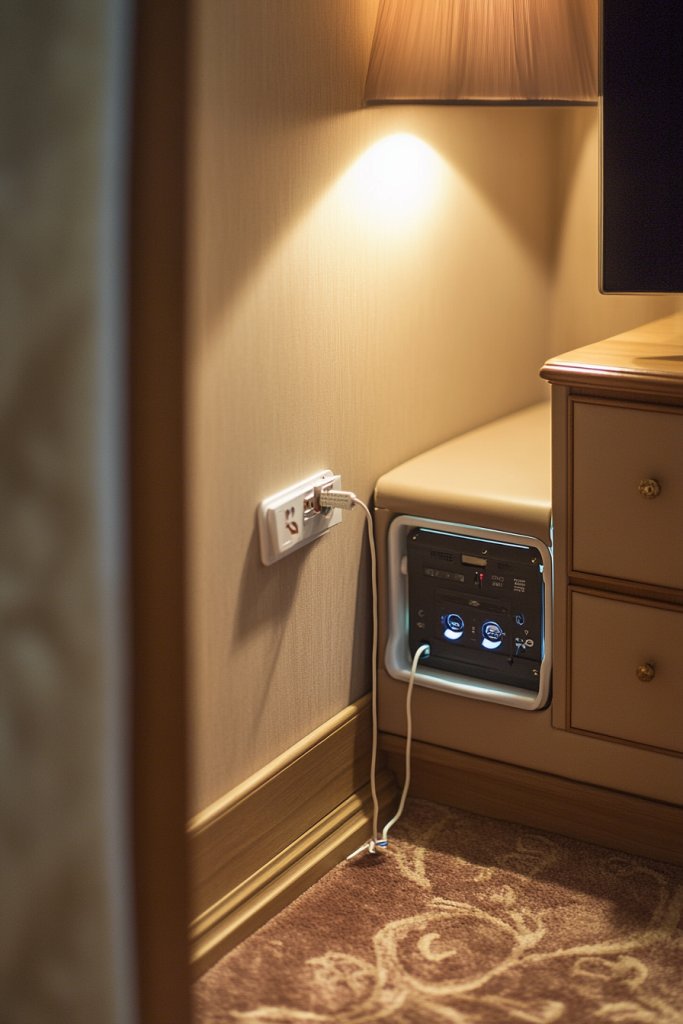
Messy cords from lamps, chargers, and electronics ruin the clean aesthetic of a nursery. Parents want a solution that keeps cables out of sight and reduces tripping hazards. Hidden cord management offers a straightforward way to tidy up and preserve that minimalist look. It’s a small detail that makes a big visual impact.
Visualize neatly routed cords concealed behind furniture or within wall channels, emerging only where necessary. Use cable covers that match the wall color, creating a seamless appearance. Cords are hidden from view as they run along baseboards or inside furniture cavities. This setup keeps the space looking organized and uncluttered, even with multiple devices in use.
Choose furniture with integrated cable management channels or install wall-mounted raceways for a sleek look. Use adhesive clips or hooks to guide cords along walls or behind furniture. For a more flexible setup, opt for wireless devices or rechargeable options, reducing cord clutter altogether. Conceal cords behind or inside furniture legs or within decorative molding for a seamless finish.
Plan your layout to identify where cords will run, and mark routing paths before installation. Use high-quality, paintable cable covers and secure them with adhesive or screws into wall studs. Keep power strips off the floor and mounted behind furniture to avoid visible clutter. Use cable ties or clips to bundle cords neatly, and replace any damaged or frayed cables promptly for safety. Regularly check the system to maintain a tidy appearance.
Coordinate cord covers with wall paint or furniture colors for a cohesive look. Label cords with subtle tags for easy identification and management. Consider decorative cable covers with textured or patterned surfaces if you want a slight design element. Keep excess length coiled and secured out of sight, and update the setup as your tech needs evolve.
Effective cord management creates a safer, cleaner nursery environment. It reduces visual noise, making your space appear more spacious and calming. Plus, it simplifies cleaning and maintenance, saving you time and frustration. With a little planning, your nursery can look effortlessly uncluttered and stylish.
15. Minimalist Play Area with Soft, Neutral Toys
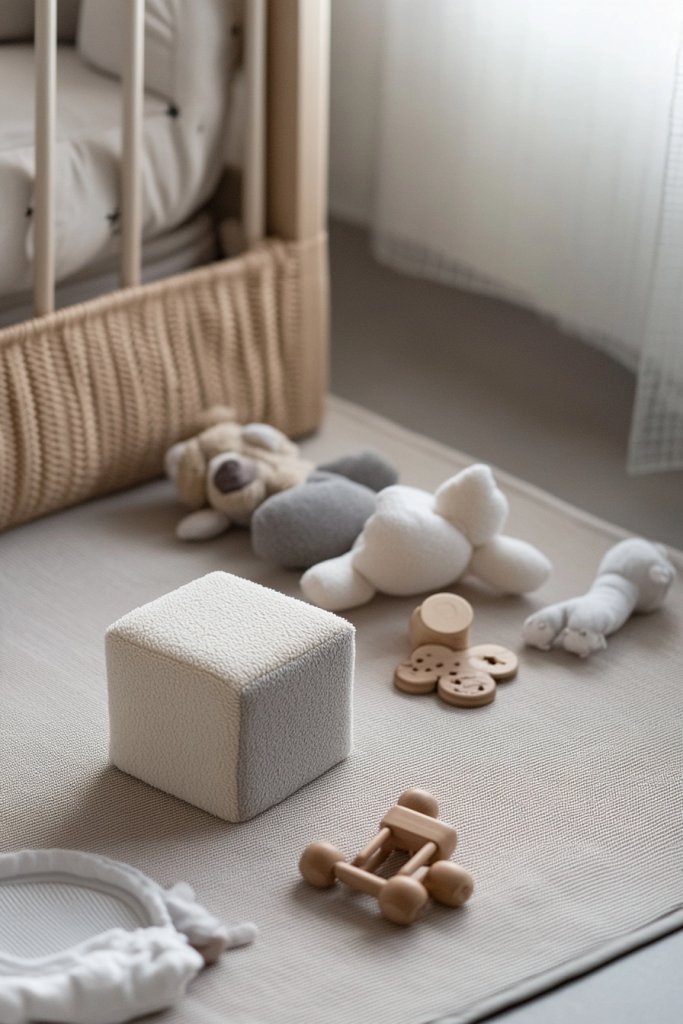
A cluttered play area quickly turns into chaos, making it hard to focus on fun and learning. Parents want a designated space that’s simple, safe, and free of overwhelming visual clutter. A minimalist play zone with soft, neutral toys creates a calming environment that encourages exploration without mess. It’s possible to have a playful yet tidy nursery.
Imagine a small corner with a soft, neutral-colored foam mat, surrounded by a few carefully chosen toys—wooden blocks, plush animals, or fabric books in gentle tones. The toys are stored in matching baskets or bins that blend into the room’s color palette. This creates a peaceful, organized space that invites your child to play and learn naturally. Natural textures and muted colors keep the area feeling light and uncluttered.
Limit the number of toys to a curated selection, rotating seasonal or themed items to keep things fresh. Use open baskets or fabric bins in neutral shades for easy access and storage. Incorporate textured or natural-finish toys to add visual interest without adding clutter. Adjust the size of the play area based on available space, and consider multi-use furniture that can double as storage.
Choose non-toxic, BPA-free toys in neutral or natural colors that coordinate with your nursery palette. Keep toys organized in low-profile, matching fabric bins or baskets that are easy for little hands to access. Regularly declutter and rotate toys to keep the area fresh and manageable. Use soft, washable mats or rugs underneath for comfort and safety.
Add subtle decorative touches like textured cushions or blankets that match your color scheme. Personalize toy storage with labels or tags for an educational touch. Incorporate a small, sculptural shelf or wall-mounted organizer for frequently used items. Keep the space feeling calm, simple, and inviting—no overstimulation needed.
A minimalist play area fosters calmness and focus, making playtime more enjoyable and less chaotic. It teaches your child the value of order and simplicity early on. With a few thoughtful choices, you create a space that’s both fun and visually harmonious. It’s proof that less really can be more in a nursery.
16. Multi-Functional Furniture with Storage Capabilities
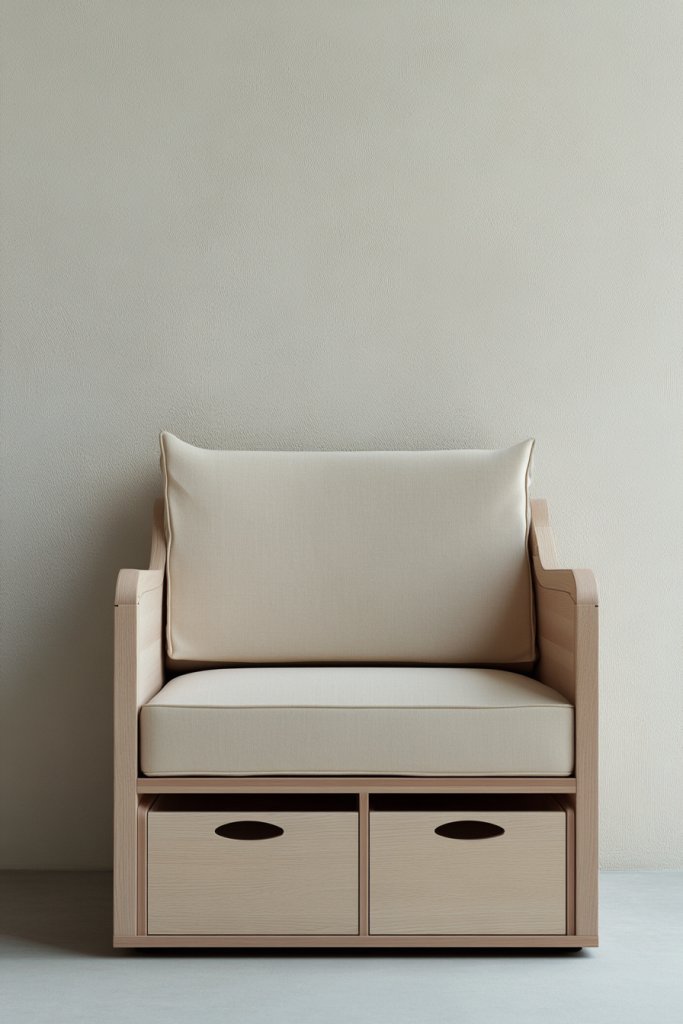
Limited space often forces parents to pick between style and function, but not anymore. Multi-functional furniture combines seating, sleeping, and storage into one sleek piece. It’s perfect for maximizing every inch of a nursery while keeping the look minimalist and clutter-free. Who says you can’t have it all?
Picture a modern crib with built-in drawers underneath, seamlessly blending into the frame. Or a stylish rocker that doubles as a storage bench, holding extra blankets or toys inside. The furniture’s clean lines and simple finishes keep the room feeling open, while hidden compartments keep everything organized. These pieces serve as both statement and storage, reducing the need for additional furniture.
Choose furniture with modular components—like a changing table with drawers or a bed with under-storage. Select finishes in natural wood, matte white, or soft gray to match your nursery’s minimalist aesthetic. For smaller spaces, opt for fold-away beds or wall-mounted options. Incorporate soft textiles or decorative handles that complement your color scheme.
Research high-quality, sturdy pieces with safety certifications. Measure your space carefully to ensure proper fit and functionality. Assemble following manufacturer instructions, paying close attention to weight limits and safety features. Use the internal storage for seasonal items or bulky essentials, keeping surfaces clear. Regularly check hardware to maintain safety and longevity.
Personalize with subtle hardware accents or painted details that match your nursery’s color palette. Use soft, washable covers or cushions to add comfort. Label storage compartments for easy organization and teach your child early about tidiness. Mix and match different furniture pieces to create a cohesive, functional nursery environment.
Multi-functional furniture proves that thoughtful design enhances both style and practicality. It helps keep the nursery uncluttered, fostering a peaceful environment for both parent and child. As your little one grows, these pieces adapt effortlessly, making your investment worthwhile. It’s a smart, stylish way to transform your nursery into a space that grows with your family.
Conclusion
This collection of minimalist nursery ideas showcases a range of styles, from cozy and tranquil to modern and chic, all emphasizing simplicity and elegance. Feel empowered to try these ideas in your own home and create a nursery that is both functional and beautiful. Embrace the simplicity and let your space reflect peace and harmony for your little one’s first home.
